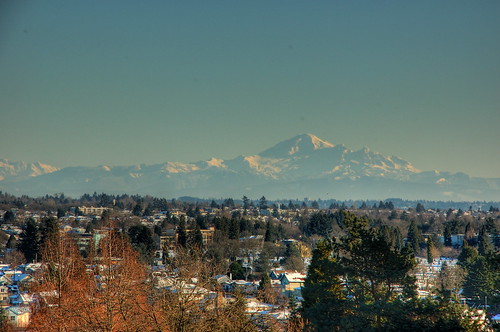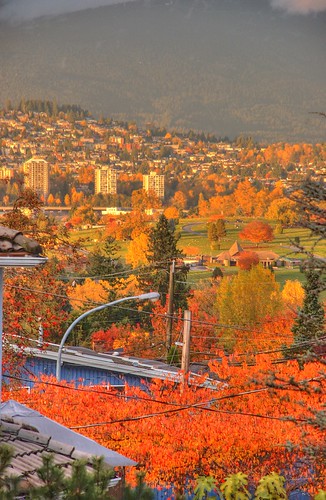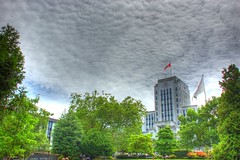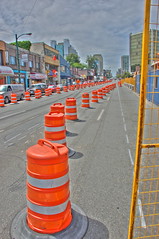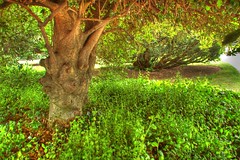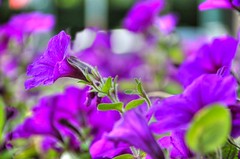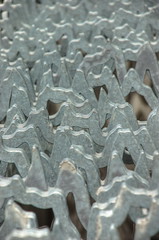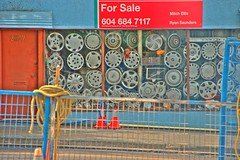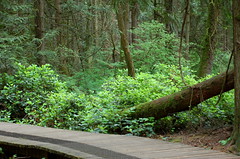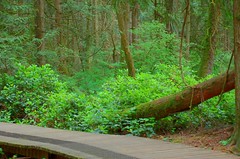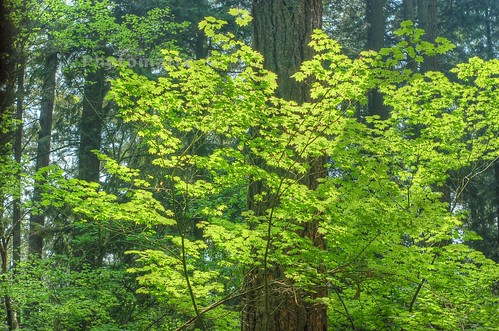Penmachine
15 December 2008
A crisp winter day
02 November 2008
Our neck of the woods
Most of the trees up here in the Pacific Northwest of North America are conifers, so we don't get the full richness of autumn colours from changing leaves. But sometimes the deciduous trees we do have are still pretty awesome:
The air was clear after much rain earlier, so the colours were particularly vibrant. My HDR treatment on the image helps too—but it's still pretty close to how it looked out our front window this afternoon.
Labels: hdr, photography, vancouver, weather
09 August 2008
Now that is serious dynamic range
I've created a few high dynamic range (HDR) photographs recently, where I combine a series of exposures (usually 3 or 5) of different durations (and which therefore see different amount of detail in shadows and highlights) into a single tone-mapped image. But nothing like this:
Yesterday's Astronomy Picture of the Day, that image, by Hartwig Luethen, combines 28 (!) pictures of last week's solar eclipse (visible mostly in northern Asia). The dynamic range is so great that the final image shows not only detail of the stupefyingly-hot corona of the Sun (photographed at 1/1000th of a second), but also features on the face of the Moon eclipsing it, lit only by the reflection from us, the Earth (photographed with a 2-second exposure).
That's pretty nifty-keen.
Labels: astronomy, geekery, hdr, photography, science
25 June 2008
High-definition Fairview
Today I had a meeting with the trial nurse for my upcoming resumed chemo treatments next month, followed by a series of blood tests, an appointment with my oncologist and the nurse again, then a CT scan. In between, I had some time to kill, so I had lunch at White Spot, then took time to walk around the Fairview neighbourhood and experiment some more with high dynamic range (HDR) photography.
Here are the results:
For each photo, I set my Nikon D50 camera to take three bracketed exposures: one at the default exposure the camera estimates, one two stops darker, and one two stops lighter. Then I used Photomatix Pro on my Mac to assemble them into HDR images, then tone-map them into the pictures you see. It's fun.
Labels: art, cancer, chemotherapy, hdr, photography, software, vancouver
19 June 2008
The green bog
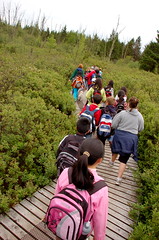 I accompanied my older daughter's school field trip to Burns Bog in Delta, south of Vancouver, today. We had fun, and managed to avoid any heavy rain.
I accompanied my older daughter's school field trip to Burns Bog in Delta, south of Vancouver, today. We had fun, and managed to avoid any heavy rain.
I also took the chance to create some more high dynamic range (HDR) photos. That involves taking three or more pictures at different exposures, and then combining them in software using a technique called tone mapping.
You can see what that does below.
On the left you can see my camera's calculated single optimum exposure, the "best pick" the camera would normally make. Nothing wrong with it. But on the right is the HDR version I created, combining the left-side exposure with two others, one brighter and one darker:
The extra vividness of colour I chose to put into the tone-mapped HDR is obvious, but if you examine the large version, you can also see a lot more detail in the shadows and highlights of the image. That's the high dynamic range we're talking about—in a normal photo, some of the shadows might be totally black, while some of the highlights might be blown out to total white.
Tone-mapped HDR photos involve a lot more decision making than traditional pictures, because depending on how you manipulate the image, its appearance can vary widely, from slightly enhanced (the way filters and darkroom work used to punch up film images) to strangely surreal (more like cross-processed, solarized, or otherwise highly altered film images).
So far I've been photographing nothing but plants in HDR for some reason, but I will play with the technique some more and post additional pictures to my Flickr HDR set.
Labels: geekery, hdr, park, photography, school, vancouver
18 June 2008
Buying your first serious digital SLR camera
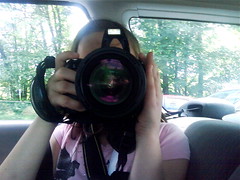 I get emails out of the blue sometimes, and yesterday a guy who found me via Flickr asked my advice on buying his first serious digital SLR (single-lens reflex) camera. He's already quite a good photographer, with a keen eye, and he's trying to decide between the Nikon D300 and Canon EOS 40D.
I get emails out of the blue sometimes, and yesterday a guy who found me via Flickr asked my advice on buying his first serious digital SLR (single-lens reflex) camera. He's already quite a good photographer, with a keen eye, and he's trying to decide between the Nikon D300 and Canon EOS 40D.
He likes the Canon's interface, but prefers the features of the D300, as well as the more vivid colours it produces (at least in JPEG mode). He wants low noise, good low-light performance, and good ability to take landscapes, high dynamic range (HDR) photos, and macro (closeup) pictures.
When you're starting out buying an SLR, what you're doing is committing yourself to a camera system, particularly with lenses. Chances are you will keep and use the lenses for much longer than you use that camera. For instance, I have a Nikon D50 I bought in 2006, but my lenses include a zoom that I bought in 1995 for my old film Nikon, and which still works great. I've been using Nikon SLRs since the early 1980s—had I chosen Canon or some other camera back then, I'd probably still be using that brand, just because of the inertia.
Both Nikon and Canon are good choices—but don't forget Pentax's K20D (Pentax provides some of the best values in both SLRs and quality lenses these days) and even Sony's A700 (Sony took over Minolta's camera business, and offers very nice Zeiss lenses too, some of the best available). I'm not a fan of the four-thirds system from Olympus and Panasonic/Leica, but you might like it.
The D300 is about 50% more expensive than the 40D (around $1800 Cdn vs. $1300 Cdn), so that might make the decision for many people. (The closest competing Nikon is actually the aging D80.) One way that price difference could affect your decision might be with lenses: if you can only afford an expensive body (like the D300) with cheaper lenses, you'd be better off getting a less expensive body (like the 40D) with better lenses like Canon's top-end L series. Again, the lenses will be around your kit longer than the body.
And for any camera you get, rather than buying yourself a standard zoom lens, I would recommend getting one or two good-quality prime (non-zoom) lenses instead. They are better optically, faster (i.e. have a larger maximum aperture letting in more light), and will also make you think about your compositions more carefully.
So I said to my questioner that if he doesn't have a brand preference for other reasons, and if he can afford the Nikon D300 with a quality lens or two, then I'd recommend it over the Canon 40D. The D300 offers excellent low-light performance, an amazing LCD screen (much better than anything Canon has), and lots of other features. Not that there's anything wrong with the 40D, but by most objective measures the D300 is superior.
As far as lenses go, if I were starting from scratch, I'd get a basic fast prime like the $140 Nikon 50 mm f/1.8 or the $500 digital-only Sigma 30 mm f/1.4. For a second lens, I'd look at either a general-purpose stabilized zoom like Nikon's well-reviewed $750 18-200 mm, or (more likely in my case) a moderate telephoto prime that can also act as a macro lens, such as Nikon's $900 Micro-Nikkor 105 mm f/2.8. If I had more money to spend, I might get both of those, or go crazy and buy the $1500 manual focus Zeiss Makro-Planar 100 mm f/2.
Canon has similar standard prime, telephoto-style macro, and zoom lenses. So do Pentax (prime, macro, zoom) and Sony/Zeiss (prime, macro, zoom, or Zeiss zoom).
It would be a pleasant luxury to be starting an SLR system from scratch, and to have maybe $4000 to spend on it. But no matter how you start, if you're a photography enthusiast, you'll get more lenses and other accessories (flash, battery grip, tripods, etc.) over time. Just don't cheap out with your lenses to start, and you'll be happier in the long run.
Labels: canon, gadgets, geekery, hdr, leica, macro, nikon, olympus, pentax, photography, sony
29 May 2008
Trying out HDR photos
Photography has been one of my hobbies since I first borrowed my dad's Pentax SLR in the 1970s. I bought my first Nikon in high school, worked on the school annual and student papers, went to a summer photo camp, and so on.
But I've never ventured into some of the more specialized areas of photography. In particular, I'm interested in macrophotography and HDR (high dynamic range) imaging. Macro (extreme close-up) pictures require specific equipment, such as a dedicated macro lens, close-up lens accessories, lens tubes, bellows, or lens-reversing hardware—so I haven't tried it yet.
HDR, on the other hand, works by simply taking different exposures of the same scene and combining them with tone mapping software such as Photomatix. After trying some varying exposures in Burnaby's Central Park yesterday with my Nikon D50, I downloaded a Photomatix demo demo today and got the following result:
My picture doesn't have the bizarro look of some extreme HDR frames, but it does have a colourful, painting-like pop that most regular photos don't, as well as lots of shadow and highlight detail. I like it.
Labels: geekery, hdr, nikon, photography
